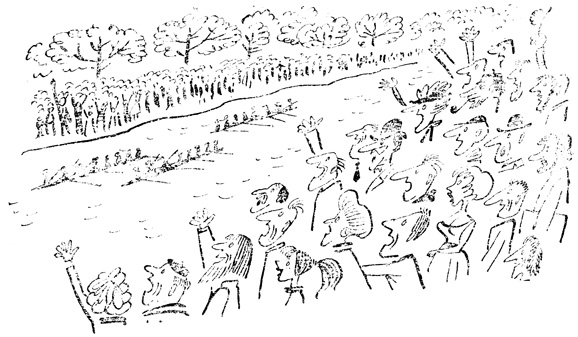
The Henley Royal Regatta
The reaches of the Thames at Henley are not only the most beautiful along the river, but, because of a straight stretch of more than a mile immediately below the town, offer an ideal course for racing shells.

The Henley Royal Regatta, established in 1839, has brought together not only the pick of English crews but, in the open events, has attracted competitors from Europe, America and Australia. Like other comparable events, it was interrupted by World Wars I and II. The course is 1 mile 350 yards with its finish near the town bridge in sheltered water, with sunny meadows and the shaded lawns of country houses on each side of the river. The races are rowed in the first week of July and furnish three days of continuous excitement to the spectators that throng the towpath and the enclosures at the finish. Because of the narrowness of the river and the many entries, the races are now rowed in heats of two or more entries. The course is protected by booms on each side, behind which spectators in punts and on houseboats moored along the banks obtain an unobstructed and close view of the competing oarsmen. There have for many years been eight events, four of which are open to amateurs; viz., the Grand Challenge Cup for eight oars (the oldest, established in 1839), the Stewards' Cup for four, the Silver Goblets for pair-oars and the diamond Sculls for single scullers. In 1939 a ninth event, the Double Sculls, was added. The Grand Chalienge Cup and the Diamond Sculls have long been the most coveted trophies in the rowing world.
Henley Regatta is very much one of those national events which is not what it was. It pays the price of being too genteel. But it is still a picturesque sight, for the surroundings of the course, set as it is between the pleasant park lands of the upper Thames, are very beautiful and the oarsmen are decked in blazers and caps and voluminous scarves of every colour or combination of colours imaginable. One additionally interesting feature of the scenery will be the number of elderly gentlemen, many of them clergymen, who are to be seen watching from banks of the river and who put on their heads for the occasion the little shrunken, faded caps originally awarded to them when they represented their school or college anything up to fifty years ago. The cap is a skull cap of the type otherwise worn only by English schoolboys. The cap and blazer habit is much favoured by cricketers as well as oarsmen, and also by tennis players and to a less extent by football players. The most impressive feature of the blazer is the badge woven on to the breast pocket. It is usually an elaborate crest done in gold or silver thread with the addition of the club's initials or motto - the last, of course, being in Latin.
|
ПОИСК:
|
© GENLING.RU, 2001-2021
При использовании материалов сайта активная ссылка обязательна:
http://genling.ru/ 'Общее языкознание'
При использовании материалов сайта активная ссылка обязательна:
http://genling.ru/ 'Общее языкознание'